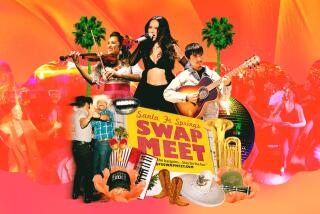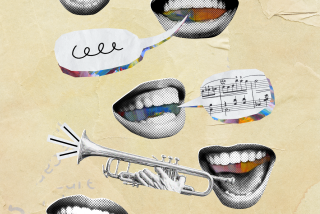The Melding Americas : Culture : Americas Prove They’re Not Always Poles Apart : Rodeos rope Brazilian hearts while Americans swing to Latin beats. But the exchange is far from even.
PRESIDENTE PRUDENTE, Brazil — The only thing missing was a Texas drawl or an Oklahoma Yee haw! because as far as American rodeos go, the thousands of Brazilians who had gathered at the exposition center here on a crisp Saturday night had almost everything else covered.
To the strains of Ricky Skaggs singing “Crying My Heart Out Over You,” local riders bolted out of the chutes atop bucking broncos and twisting, snorting bulls with names like No Future.
Other cowboys, their leather chaps flapping, roped and wrestled steers to the ground, while cowgirls ran their mounts through the barrel races.
In the crowd, cowpoke wanna-bes were decked out in proper Western wear--broad-brimmed hats, silver-buckled embroidered belts and Wrangler jeans (the special “Rodeo Endorsed” edition) that hung just so atop the Tony Lama boots.
Those who arrived without the proper accouterments needed only to mosey over to the Simpson Bros. Western Wear trailer. There, salesman Celso Marcello was happy to show them a pair of Justin boots, lead them through a variety of spurs, lariats and other Western paraphernalia--”straight from Texas,” he boasted in Portuguese--or fit them into jeans that advertised, in English, the much-sought-after “cowboy cut.”
And what cowboy would be complete without his chewing tobacco. Marcello offered both Beech-Nut and Skoal.
The Wild West, or at least the 20th-Century version of the uniquely North American phenomenon, had come to this mid-sized town tucked about 300 miles southwest of Sao Paulo. It was just one example of entwined cultures of the Americas.
From basketballs to soccer balls, Snoop Doggy Dogg to Julio Iglesias, McDonald’s to Taco Bell, “True Lies” to “Like Water for Chocolate,” the popular cultures of the two halves of the hemisphere have washed against each other, leaving their marks in obvious and not so obvious ways.
“You see it everywhere,” said Carlao Andrade, owner of a Rio de Janeiro record company and recording studio that handles mainly American clients. “I go to the States, and I see things that are Brazilian or at least from Latin American countries. And here, you see the (U.S.) influence in almost everything.”
Kindergartners at the Sierra Nevada school in Mexico City decorate their classrooms for Thanksgiving, while elementary students in New Orleans celebrate Mexican Independence Day.
American authors such as Stephen King and Sidney Sheldon are perennial best sellers in Latin American countries, while Brazilian Jorge Amado, Colombian Gabriel Garcia Marquez and Mexican Carlos Fuentes are renowned in U.S. literary circles.
In Latin America’s two most populous nations--Mexico and Brazil--delivery boys hustle up and down city streets with red, white and blue Domino’s Pizza boxes, just as they do in hundreds of U.S. cities. Meanwhile, Chilean families settle down to meals of empanadas , as do diners at the Las Pampas restaurant in Washington, D.C.
The regions have even swapped slang. Hipsters in U.S. urban centers have long greeted each other casually with the phrase que pasa , while surfers in Portuguese-speaking Rio de Janeiro refer to each other as Bro. Hasta la vista , thanks in large part to Arnold Schwarzenegger, has become a household phrase in remote American towns such as Sylacauga, Ala., while throughout Latin America OK is a universal term of approval.
Each hemispherical pole influences the other, but the exchange is far from even.
Despite a long history of Latin influence in the United States that includes Afro-Cuban music in the 1930s, Mexican mural painting in the 1940s, Brazilian bossa nova in the 1950s and South and Central American architectural styles throughout the century, Latin culture in America is still for the most part segregated in the communities of Spanish-speaking immigrants or naturalized Latino citizens.
For example, while music by American pop stars is routinely mixed into the radio formats of salsa and samba in South and Central America, Latin-influenced music in the United States is primarily limited to Spanish-language radio stations.
American television programs, dubbed in Spanish or Portuguese, are routinely broadcast on Latin stations, but Latin-originated programming is almost never seen on English-language channels in the United States.
“That’s true,” said Broderic Camp, professor of Latin American studies and head of the political science department at Tulane University in New Orleans. “I don’t think it’s really directed at Latin American culture. It’s just that in America we’ve always been more focused on ourselves than other cultures.”
Still, the cultural fertilization is far from being a one-way street, Camp said.
“The fact is that Latin America has really replaced France as the most significant external cultural influence in the United States,” he said. The most obvious areas are art, food and music.
“The (Latin) music is now so entwined with most popular music that you can’t be a real musician today without understanding Latin rhythms,” said drummer Ndugu Chancler, who has played with artists from Miles Davis to Carlos Santana. “And not only that, you have to be able to differentiate between Afro-Cuban and Brazilian rhythms.”
Nevertheless, U.S. culture has made a far greater impact in the hemisphere, as evidenced by the rodeo trappings in the Brazilian interior. There, pickup trucks are the rage. Local discos play country music, both American and an American-influenced Brazilian brand called caipiria .
The onslaught of things North American has been fueled by the pervasive presence of U.S. television programs, movies and a rapidly growing fast-food franchise industry that fosters the American way of life.
Throughout Latin America, which has minuscule film industries, American movies are the staple, representing at least 80% of the market. Of the top 50 video rentals in Brazil last year, for example, only one was not a U.S.-made film.
“Our movies do sell America and an American way of life, both the good and the bad “ said Harry Stone, senior vice president for the Motion Picture Assn. of America, with offices in Rio de Janeiro.
And South Americans are regular TV watchers of “Cheers,” “Golden Girls,” “L.A. Law,” “Star Trek: Deep Space Nine,” “Baywatch” and American sports.
American music has flooded into Latin America via radio and MTV. Aerosmith is ranked in the Top 10 in Peru and Argentina; Toni Braxton holds a Top 10 spot in Chile.
“The music changed the way people wanted to dress, the way they walk, the way they talk,” said Johnny Pereira, who programs American music for a dozen Brazilian radio stations. “You’ve got Brazilian rappers, just everything.”
The influx has been met with mixed feelings.
“There’s good and bad,” said Laura Cerrato, a professor of literature at the University of Buenos Aires. “What we get is the most mediocre of American literature, Stephen King and Sidney Sheldon. We get Michael Jackson and Madonna, but we don’t get some of the better music or better literature. At least in America the buyer gets a chance to choose.”
“The good,” Mexican author Homero Aridjis said, “is that the American political culture, with its democracy and division of powers, is an impressive model for freedom.”
But like many, Aridjis worries that Latin America will be drowned by the American cultural wave: “The Mexican culture is losing its own identity and imitating American standards of life and culture due to the invasion of American TV and films. America exports its violence and consumerism. . . . Mexican youth watch these shows and want to go out and imitate what they see. . . . It’s a tough issue. The question is whether we can prevent American culture from killing off our own.”
Times staff writer Jube Shiver in Washington and researcher Susan Drummet in Mexico City contributed to this story.
More to Read
Sign up for Essential California
The most important California stories and recommendations in your inbox every morning.
You may occasionally receive promotional content from the Los Angeles Times.










